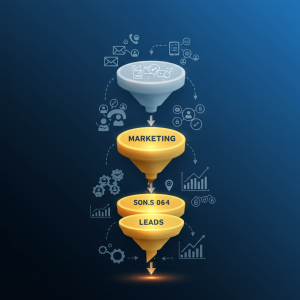How to Improve Inbound Marketing

Every business practicing inbound marketing eventually faces a common challenge: diminishing returns from previously successful tactics. The initial excitement of watching organic traffic grow gradually gives way to plateaus, conversion rate stagnation, and increasing customer acquisition costs. Yet these challenges don’t indicate inbound marketing’s limitations—rather, they signal the need for strategic evolution beyond foundational practices.
While creating blog posts, optimizing for search, and maintaining social media accounts form the backbone of inbound marketing, truly transformative results require deeper strategic thinking. Businesses breaking through performance plateaus typically move beyond these basics to implement nuanced approaches that better align with evolving buyer behaviors and market conditions.
Shifting from Content Volume to Strategic Value
Many organizations fall into the trap of equating content volume with inbound marketing success. This misconception leads to production calendars packed with low-impact content that fails to serve specific business objectives or address genuine audience needs. Breaking free from this pattern requires fundamental shifts in content strategy.
Content marketing pioneer Jay Baer aptly described this evolution: “Successful inbound marketing increasingly depends not on how much content you create, but how well that content serves specific segments of your audience at precise moments in their journey.” This perspective emphasizes quality, relevance, and timing over sheer production volume.
Consider auditing existing content against actual business results rather than traffic metrics alone. Which pieces genuinely influence pipeline development? Which convert at higher rates? This analysis often reveals that certain content types, topics, or formats dramatically outperform others in driving meaningful outcomes beyond pageviews.
Research from Orbit Media Studios supports this approach, finding that longer, more thoroughly researched content pieces updated regularly generate significantly better results than higher volumes of shorter, superficial content. Their annual blogging survey reveals that posts exceeding 1,500 words generate 3.5x more leads than shorter counterparts, suggesting depth often matters more than frequency.
Aligning Content with Buyer Journey Stages
Inbound marketing often underperforms when content distribution skews heavily toward certain funnel stages while neglecting others. Many companies overinvest in awareness-stage content while providing insufficient resources for consideration and decision stages where conversion actually happens.
Effective journey mapping helps identify these imbalances by documenting prospect paths from initial awareness through purchase decisions. This mapping typically reveals content gaps preventing smooth progression between stages—gaps that, when filled, can dramatically improve conversion rates without increasing top-of-funnel traffic.
For existing content, consider implementing clearer next steps between journey stages. Each piece should naturally guide prospects toward logical next actions rather than leaving them at dead ends. This connective tissue between funnel stages often proves more valuable than creating additional standalone content pieces.
Leveraging Data Beyond Basic Analytics
Basic analytics provide useful starting points but rarely reveal the insights needed for transformative improvement. Organizations achieving breakthrough results typically implement more sophisticated measurement approaches that reveal deeper patterns in prospect behavior.
Consider moving beyond pageview metrics to implement content attribution models that track how specific assets influence pipeline development and revenue generation. These models reveal which content truly drives business results rather than merely attracting traffic—information crucial for strategic resource allocation.
Similarly, implementing progressive profiling helps build richer prospect profiles over time instead of overwhelming visitors with excessive form fields. This approach improves conversion rates while gradually collecting the detailed information needed for meaningful personalization.
The most sophisticated teams combine behavioral data with direct customer research through interviews, surveys, and analysis of sales conversations. According to Gartner research, organizations integrating direct customer feedback with behavioral data improve marketing ROI by up to 15% through better alignment with actual buyer needs and preferences.
Personalizing Beyond Basic Segmentation
Basic demographic or firmographic segmentation provides useful starting points but rarely delivers the personalization sophistication modern buyers expect. Improving inbound marketing often requires more nuanced approaches that reflect specific buying contexts and individual needs.
Intent data has emerged as a powerful resource for understanding prospects’ current priorities and challenges. By recognizing research patterns indicating active buying journeys, marketers can prioritize outreach and personalize content for prospects demonstrating genuine interest rather than treating all visitors equally.
Behavioral segmentation offers another powerful evolution, adapting content experiences based on observed actions rather than static attributes. This approach ensures prospects encounter content matching their demonstrated interests and engagement patterns rather than presumed preferences based on demographic profiles.
For organizations ready to dramatically improve inbound performance, visit our personalization strategy guide for implementation frameworks tailored to various business models and technology environments.
Integrating Inbound with Broader Marketing Ecosystem
Isolated inbound marketing programs typically underperform compared to strategies seamlessly integrated with broader marketing and sales processes. Breaking down these artificial boundaries often catalyzes significant performance improvements without requiring entirely new initiatives.
Account-based marketing approaches can complement traditional inbound by focusing resources on specific high-value target accounts. This integration aligns content creation with business development priorities while ensuring sales and marketing teams collaborate toward shared objectives rather than pursuing separate metrics.
Sales enablement represents another crucial integration point. Equipping sales teams with insights from prospect content engagement helps them continue conversations naturally from digital interactions rather than starting from scratch. This continuity dramatically improves prospect experiences while shortening sales cycles.
Email marketing deserves particular attention for integration opportunities. Rather than sending generic newsletters, consider triggered email sequences activated by specific content interactions that indicate interest in particular topics or solutions. These behavior-based communications typically generate significantly higher engagement than broadcast approaches.
Optimizing Technical Performance
Content quality and strategic sophistication matter enormously, but technical factors significantly influence inbound marketing effectiveness. Several technical optimizations often yield outsized returns relative to their implementation effort.
Site speed has emerged as a critical factor for both user experience and search visibility. Google’s Page Experience update explicitly incorporates loading speed into ranking algorithms, while user data consistently shows sharp abandonment rate increases when pages load slowly. Implementing image optimization, browser caching, and content delivery networks often delivers immediate performance improvements.
Mobile experience optimization continues growing in importance as mobile traffic percentages increase across nearly all industries. Beyond responsive design, consider mobile-specific content formats and interaction patterns that acknowledge the different contexts and behaviors of mobile users.
Structured data implementation helps search engines better understand and showcase content, potentially increasing click-through rates from search results. While this technical SEO element receives less attention than keyword optimization, it often delivers significant visibility improvements for existing content without requiring complete rewrites.
Expanding Content Formats and Distribution Channels
Even successful inbound marketing programs sometimes stagnate by overrelying on familiar content formats and distribution channels. Strategic expansion into additional formats often reaches new audience segments while breathing fresh life into existing topics.
Video content continues showing exceptional engagement metrics across nearly all industries, yet many organizations still allocate disproportionate resources to written content. Consider converting high-performing written pieces into video formats that present similar information through different learning modalities.
Interactive content—including assessments, calculators, configurators, and quizzes—typically generates significantly higher engagement and conversion rates than static alternatives. These formats create active participation that increases information retention while providing valuable data about prospect priorities and challenges.
Podcasting offers another powerful expansion opportunity, particularly for reaching audiences during commutes or other activities incompatible with visual content consumption. The intimate nature of audio content often builds stronger audience relationships than more impersonal formats.
Conclusion
Improving inbound marketing results rarely requires abandoning existing programs entirely. Instead, strategic evolution, targeted optimizations, and thoughtful integration with broader marketing functions typically unlock significant performance improvements from foundations already in place.
Organizations achieving breakthrough results typically focus on quality over quantity, implement more sophisticated measurement approaches, personalize beyond basic segmentation, and integrate inbound tactics with complementary marketing disciplines. These evolutionary steps transform inbound marketing from isolated content creation into strategic business development that measurably impacts revenue growth.
The most successful practitioners recognize inbound marketing not as a static set of tactics but as a dynamic discipline requiring continuous refinement based on performance data and evolving market conditions. This perspective of constant improvement rather than rigid implementation distinguishes truly exceptional inbound marketing programs from those generating merely adequate results.







